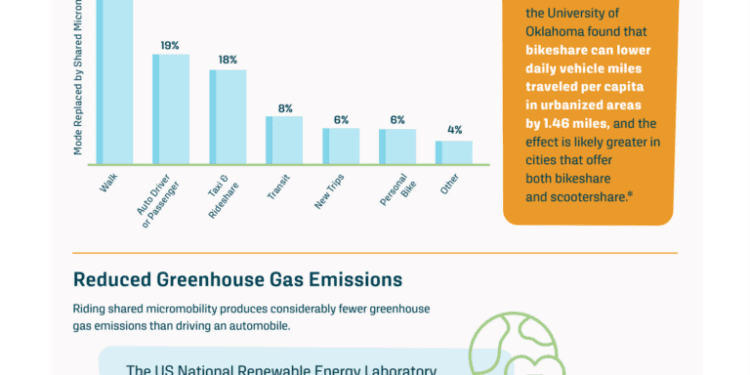In 2022, micromobility options were available in 401 cities across North America, with 363 of those cities located in the United States. Of those cities, 30% offered both scootershare and bikeshare systems, while 36% offered scootershare only and 34% offered bikeshare only. All scootershare systems were electric, while bikeshare systems consisted of both electric and pedal bikes, with electric bikes accounting for 55% of the total.
Shared micromobility systems provide short-term access to bikes and scooters on an as-needed basis, and do not include personal bikes and scooters. This data was collected by the North American Bikeshare and Scootershare Association in their 2022 Shared Micromobility State of the Industry Report.
The Vehicle Technologies Office of the US Department of Energy released an image to accompany the report, showing the percentage of cities in the US offering shared micromobility systems. The image showed that 30% of cities offered both scootershare and bikeshare, 36% offered scootershare only, and 34% offered bikeshare only.
The data from this report shows that micromobility options are becoming increasingly popular in North America, with more cities offering shared systems than ever before. This is a positive trend for those looking for sustainable transportation options, as electric scooters and bikes are a great way to reduce emissions and get around quickly.
FAQ
Q1. How electric car batteries work?
A1. Electric car batteries are typically lithium-ion batteries that store energy and power the motor. They are recharged by plugging the car into an electric outlet or charging station.
Q2. What electric car has the longest range?
A2. The Tesla Model S has the longest range of any electric car currently on the market, with a range of up to 370 miles on a single charge.
Q3. How electric car chargers work?
A3. Electric car chargers work by connecting the car to an electrical outlet or charging station and transferring electricity from the outlet to the car’s battery. The charger then monitors the battery’s charge level and stops charging when the battery is full.







